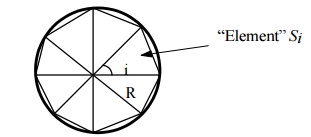Chapter: Mechanical : Finite Element Analysis : Finite Element Formulation of Boundary Value Problems
Finite Element Method (FEM) or Finite Element Analysis (FEA)
FINITE ELEMENT FORMULATION OF BOUNDARY VALUE
PROBLEMS
INTRODUCTION
The finite element method constitutes a general
tool for the numerical solution of partial differential equations in
engineering and applied science.
The finite element method (FEM), or finite element
analysis (FEA), is based on the idea of building a complicated object with
simple blocks, or, dividing a complicated object into small and manageable
pieces. Application of this simple idea can be found everywhere in everyday life
as well as in engineering.
Examples:
Lego
(kids’play)
Buildings
Approximation
of the area of a circle:

Why
Finite Element Method?
·
Design analysis:
hand calculations, experiments, and computer simulations
·
FEM/FEA is the most widely applied computer
simulation method in engineering
·
Closelyintegrated with CAD/CAM applications
1.A Brief History of the FEM
·
1943 --- Courant (variational method)
·
1956 --- Turner, clough, martin and top(stiffness)
·
1960 --- Clough (finite element plan problems)
·
1970 --- Applications on mainframe computer
·
1980 --- Microcomputers, pre and post processors
·
1990 --- Analysis of large structural systems
2.General Methods of the Finite
Element Analysis
2. Force
Method – Internal
forces are considered as the unknowns of the problem.
3.
Displacement or stiffness method –
Displacements of the nodes are considered as the unknowns of the problem.
3.General Steps of the Finite
Element Analysis
·
Discretization of structure
·
Numbering of Nodes and Elements
·
Selection of Displacement function or
interpolation function
·
Define the material behavior by using Strain –
Displacement and Stress – Strain relationships
·
Derivation of element stiffness matrix and
equations
·
Assemble the element equations to obtain the
global or total equations
·
Applying boundary conditions
·
Solution for the unknown displacements computation
of the element strains and stresses from the nodal displacements
·
Interpret the results (post processing).
4.Objectives of This FEM
·
Understand the fundamental ideas of the FEM
·
Know the behavior and usage of each type of
elements covered in this course
·
Be able to prepare a suitable FE model for given
problems
·
Can interpret and evaluate the quality of the
results (know the physics of the problems)
·
Be aware of the limitations of the FEM (don’t misuse
the
·
FEM - a numerical tool)
5.Applications of FEM in
Engineering
·
Mechanical/Aerospace/Civil/Automobile Engineering
Structure analysis (static/dynamic, linear/nonlinear) Thermal/fluid flows
·
Electromagnetics
·
Geomechanics
· Biomechanics
Related Topics